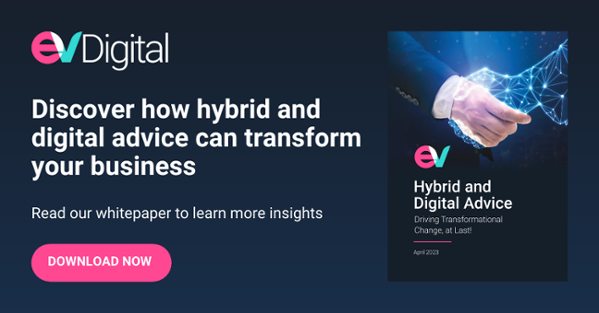EV: The potential of digital and hybrid financial advice in bridging the gap

We recently held a roundtable with people from around the financial services industry to discuss the opportunities and challenges presented by digital and hybrid financial advice solutions. In this blog, we bring you the highlights of the discussion, views from the delegates, and some insightful conclusions from the day.
The event launched our latest white paper, Hybrid and Digital Advice: Driving Transformational Change, at Last!, which argues that financial services firms need to embrace hybrid and digital advice solutions to improve access to financial planning for the millions of people who currently can’t or won’t take traditional advice. Our new paper follows a 2017 EV white paper examining digital advice's transformative potential.
Six years on, while some progress has been made, and we’ve seen considerable industry interest in digital and hybrid approaches, consumers are yet to experience its full advantages.
With more and more people needing financial advice, we believe we’ve now reached a point where the industry must find a way to bridge the gap between full-service financial advice, which often comes with high fees, and guidance, which falls short for many individuals, especially in more complex areas like retirement planning.
The opportunity
Using hybrid and digital advice solutions offers a huge opportunity for financial services businesses to lower costs and deliver greater choices for consumers while at the same time reducing the cost of providing advisory services to improve their long-term profitability. However, firms like Vanguard and Quilter closing their hybrid propositions highlights the challenges of delivering successful hybrid solutions.
Our roundtable discussion, with representatives from Hargreaves Lansdown, St. James’s Place, Goldman Sachs, Origen Financial Services, Ammonite, SEI, LV=, Isio and EV, explored the potential of digital and hybrid advice as well as the difficulties faced by firms in implementing solutions.
On the day, we looked at six key areas:
1. Reducing the cost of financial advice
It’s generally accepted that most people would benefit from accessing financial advice, particularly when they are approaching or at retirement. Research into the advice gap tells us that more people would take financial advice if it were cheaper.
Using technology to reduce the cost of advice has been a longstanding conversation within the advice sector, and most of our participants agreed that much could be done to improve adviser efficiency through more streamlined and automated processes. However, many felt that the need for personalised support based on the customer’s financial circumstances makes fully automating this process difficult.
Some participants also felt that fully transforming advice through digital processes to reduce the cost is currently hampered by regulatory requirements, even for simplified advice.
Goldman Sachs:
“For us, the key challenge is trying to get what the FCA classes as simplified advice proved in such a way that it does reduce costs because fewer advisers are needed. Also, when we're actually producing that product, we want to know that it's not going to be so selective that you end up losing half the client base as they go through the process because there's so many questions.”
2. Increasing customer engagement
Engaging consumers in the advice process earlier is crucial to supporting better financial outcomes. However, the consensus around the table was that the value of financial advice is not widely understood. Many felt that earlier engagement with investment and pension saving, particularly through workplace education, will help people recognise the benefits of advice and leave them better prepared for the decisions they will need to make at different life stages, including retirement.
Some believe that the customer should have the additional option of hybrid advice and that a better understanding and imparting the value of advice would leave people more willing to pay for the financial security it can deliver.
Rob Harradine, Ammonite:
“I think as an industry, we're quite poor at getting across the incredible value that financial planning and advice can bring, especially in the conversations we have early on. Many people are deeply worried about whether they will have enough money in retirement or don't know if they can afford to protect their family. By taking the opportunity to engage more online with people through a Zoom or a Teams call, which reduces the cost significantly of going and having a conversation in person with clients, you can touch in and educate them with online tools and highlight the importance of having an adviser by their side”
3. Offering greater customer choice
Currently, customers have limited choices when it comes to taking financial advice.
There is regulated holistic financial advice where the adviser is responsible for the recommended course of action, but it’s not accessible to everyone. Or there’s guidance available to all, but the customer takes full responsibility for their choices.
There are a few digital and hybrid advice solutions in the middle, but these are generally distinct propositions or channels, making it difficult for customers to switch between different types of guidance and advice as their needs change.
Around the table, views on how firms would combine different channels differed. In general, it was felt that customers should be able to decide how they interact with financial products and services. Hybrid and digital advice were expected to feed in, to a greater or lesser extent, different advice propositions to support greater choice.
Ross McLachlan, Hargreaves Lansdown:
“At the moment we have a fairly binary proposition, where you've got an execution-only platform and then you've got full financial advice. The gap in the middle, that leap of knowledge and cost, is too much for many clients to overcome. What we're looking at doing is broadening out the digital tools and the human interactions in the middle, to act as a stepping-stone between those options, so there’s a spectrum. Clients are then able to understand more themselves, understand what they don't know, and understand how an adviser can then help them with the problems that they face.”
4. Managing risk
When implementing digital and hybrid advice, firms need to consider how they will manage compliance risk and the ongoing quality control of service levels. The more firms automate the advice journey, the more trust they need to place in the tools and solutions they are using.
The table agreed that digital and hybrid offers an enormous opportunity, but many argue we still need to overcome the risks associated with giving advice based on algorithms, especially the potential for ‘mass compliance risk’ if flaws are found retrospectively in the digital process. Others felt advances in technology meant that these risks could be significantly reduced, while some believed there would always be a need for human reviews.
John O'Driscoll, St. James's Place:
“Even where advice is delivered digitally, firms will need some kind of gate on the front. The person delivering the advice will need to understand what's going on and to take responsibility for the advice.”
5. Identifying the priorities
The participants were asked about their business priorities for implementing digital and hybrid solutions. Perhaps understandably, these differed from firm to firm. Improving client engagement was seen as crucial for many, but other priorities included better data management, making the most of artificial intelligence and improving digital capabilities.
Mike Morris, Origen Financial Services:
“I think we need to stimulate demand for advice first. You can build a great digital or hybrid product, but if people aren't engaged enough to use it, then it's not going to go anywhere. At the moment, people are not taking advice. Well, why not, because advice is available? It's how they get to the point of thinking, I need to get some advice at 55, it's the right thing to do and then I can engage with these providers. At the moment, they're not thinking that.”
6. The future of advice businesses
The roundtable concluded by asking participants to consider the future advice landscape and what advice firms of the future would look like. The table agreed that there wouldn’t be just one advice model in the future.
Banks, insurers and workplaces, which have easy access to large numbers of consumers, were seen as key players in promoting financial advice in the future.
However, most felt there will always be a need for traditional human financial advisers, heavily supported by technology to improve efficiency, consistency and personalisation.
All told, plenty of consensus around the table, but also some areas of concern. It’s a question of watching this space as digital and hybrid solutions mature and undoubtedly take their place in the spectrum of advice and guidance.
So what next?
At EV, we can demonstrate how embedding the right tech can help advice firms build a low-cost mass-market proposition while remaining profitable, with efficiencies arising from not requiring more hands on deck when scaling up. By implementing a spectrum of advice capacities – adding digital and hybrid models to traditional face-to-face full service – the firm can be transformational in providing more value and consistently creating better outcomes for more people while enhancing business performance, market competitiveness and mutual prosperity.
You can also book a discovery call today to learn how EV can partner with your firm to enhance the advice journey and give your clients the quality and depth of service, support and information they expect today and in the future.
